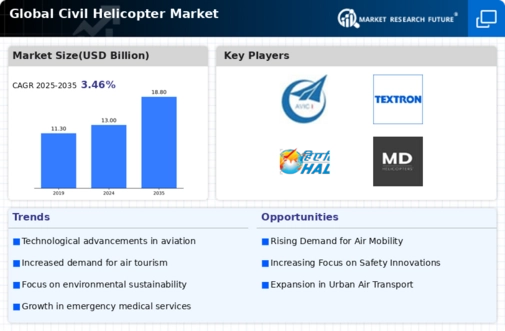Top Industry Leaders in the Civil Helicopter Market
Global Civil Helicopter Market
On July 29, 2023, The Ministry of Civil Aviation (MoCA) India announced its plan to address the growing need for helicopter operations nationwide. Civil helicopters improve accessibility, particularly in remote areas and in facilitating tourism. Their unmatched utility is key in emergency medical and disaster management services during floods, rescue operations, etc. Being a major economy, India wants to boost its helicopter operations.
On July 06, 2023, Airbus Helicopters announced selecting Thales' integrated electronic standby instrument (IESI) to guarantee flight safety on new civil and military helicopters. Thales's new-generation IESI provides vital data to enhance flight safety, even if other cockpit equipment fails. Thales' third-generation IESI will be used to improve Airbu's new H135, H145, H160, and H175 civil and military helicopters.
On Jun.19, 2023, At the Paris Air Show 2023, Bell Textron, Inc. announced the expansion of its offering across other civil aircraft to leverage their designs and capabilities. The Bell 412 integrates new upgrades into a proven platform originally deployed as the Huey, while The Bell 505 can be configured as a military trainer and shares the same glass cockpit avionics as the 407M. The Bell 429 is configured as a law enforcement demonstrator, featuring the best tail rotor authority in its class.
On March 18, 2023, Germany's Defence Ministry announced its plan to buy Airbus civil helicopters and convert them for combat. 82 Airbus H-145M civil helicopters will be converted into combat helicopters to replace the Tiger combat fleet. Last year, Germany's Defence Ministry shifted its policy, committing 100 BN Euros ($107 BN) to modernize its Bundeswehr armed forces.

The civil helicopter industry has seen several notable innovations in recent years, driven by advances in technology, safety considerations, environmental concerns, and the need for more efficient operations. These innovations have improved helicopter performance, safety, and environmental sustainability. Here are some key innovations in the civil helicopter industry:
Fly-by-Wire Systems: Fly-by-wire technology has been increasingly integrated into civil helicopters. It enhances flight stability, reduces pilot workload, and allows for advanced flight control modes. This technology provides a smoother and more precise flying experience.
Rotor Blade Technology: Advanced rotor blade designs and materials, such as composite materials, have improved the efficiency, aerodynamics, and noise levels of helicopters.
Noise Reduction: Noise pollution from helicopters has been a concern in many urban areas. Innovative designs, including quieter rotor blades, advanced soundproofing, and modified flight profiles, aim to reduce noise emissions.
Advanced Avionics: Helicopters are equipped with state-of-the-art avionics systems, including glass cockpits, digital displays, and integrated navigation systems that improve situational awareness for pilots.
Autopilot Systems: The integration of advanced autopilot systems and stability augmentation systems (SAS) enhances safety and reduces pilot workload, particularly in challenging flight conditions.


